
The Financial Sector (XLF) 50-day EMA crossed down through the 200-day EMA, a death cross, generating a LT SELL Signal. Also note that since the January price top, there is a series of lower tops and lower bottoms defining a falling trend. The tops are accelerating downward creating a bullish descending wedge. While that is a bullish pattern, internals are still bearish given weak participation and falling momentum. This could be a support level for a reversal, but we aren't optimistic.
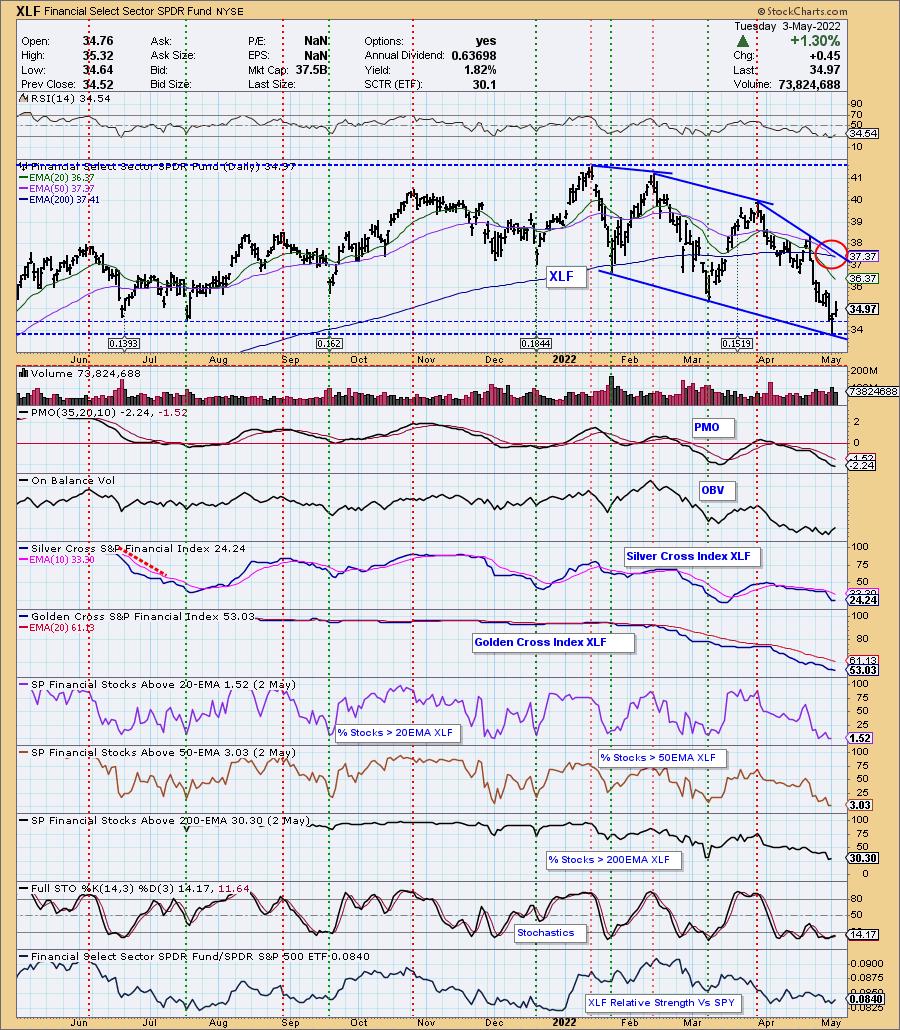
__
The Gold ETF's (GLD) 20-day EMA crossed down through the 50-day EMA, a dark cross, generating an IT Trend Model NEUTRAL Signal. Had the crossover occurred beneath the 200-day EMA it would have been a SELL signal.
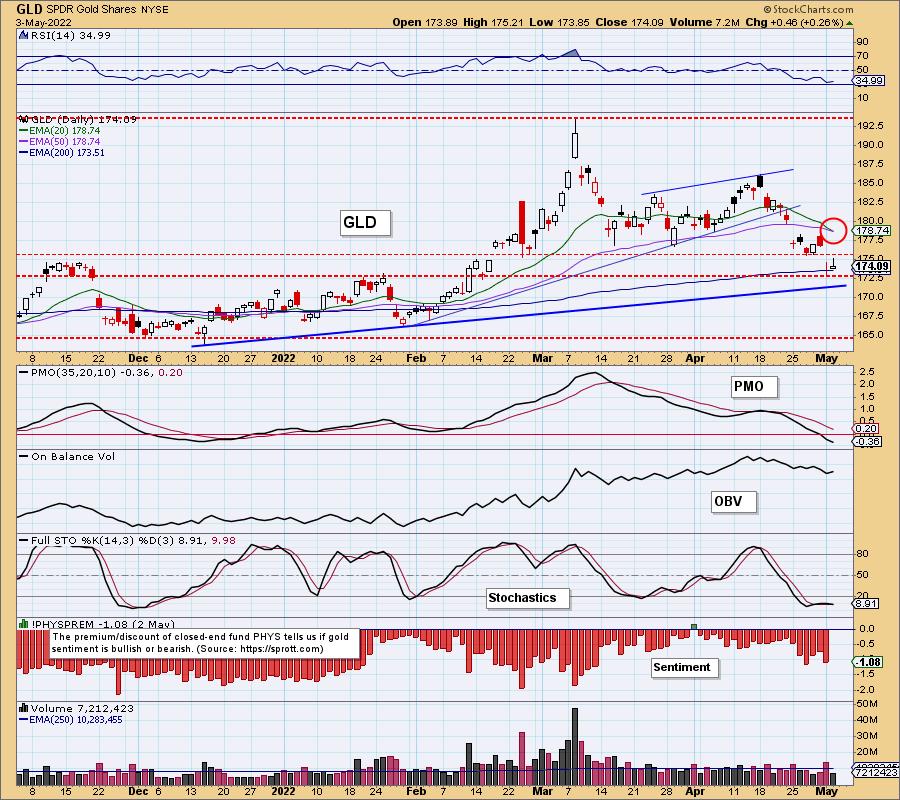
__
The Health Care Sector (XLV) 20-day EMA crossed down through the 50-day EMA, a dark cross, generating an IT Trend Model NEUTRAL Signal. Indicators continue to look very negative alongside weak participation. Look for a test of the February lows.
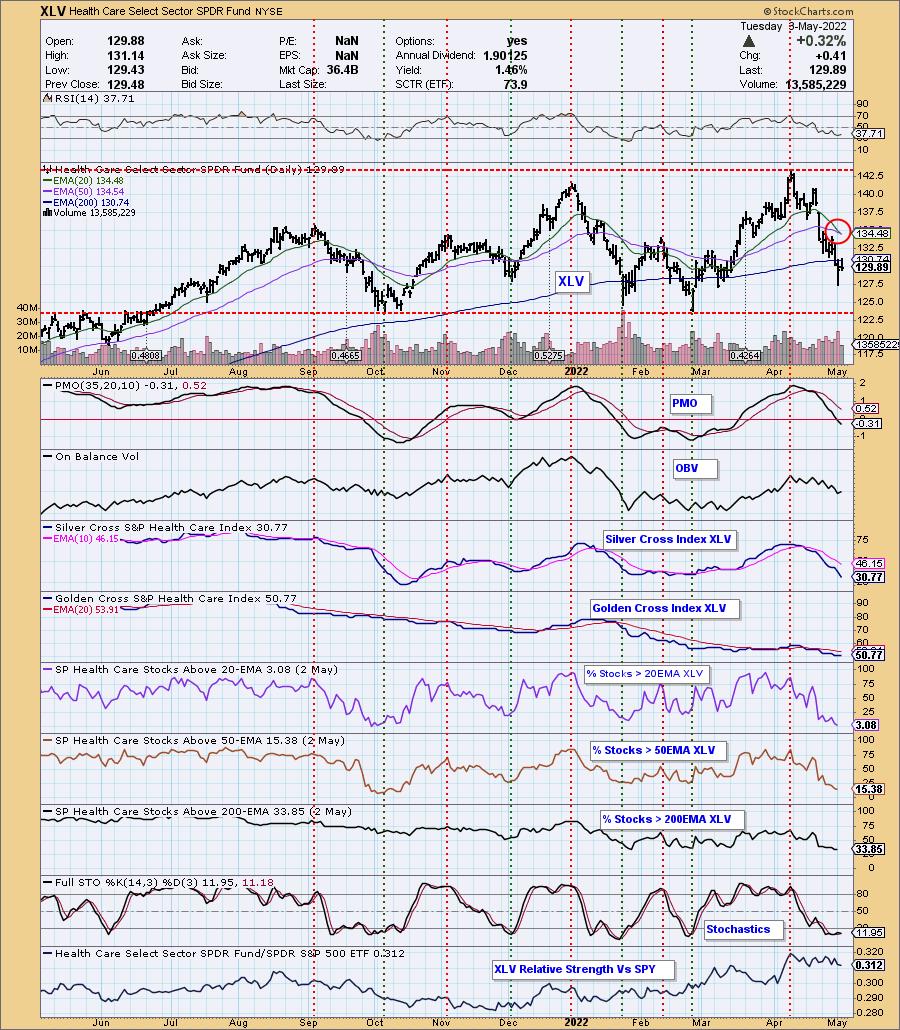
The DecisionPoint Alert Weekly Wrap presents an end-of-week assessment of the trend and condition of the Stock Market, the U.S. Dollar, Gold, Crude Oil, and Bonds. The DecisionPoint Alert daily report (Monday through Thursday) is abbreviated and gives updates on the Weekly Wrap assessments.
Watch the latest episode of DecisionPoint on StockCharts TV's YouTube channel here!
MAJOR MARKET INDEXES
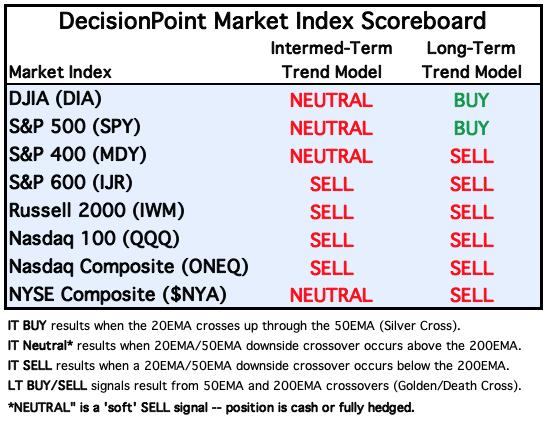
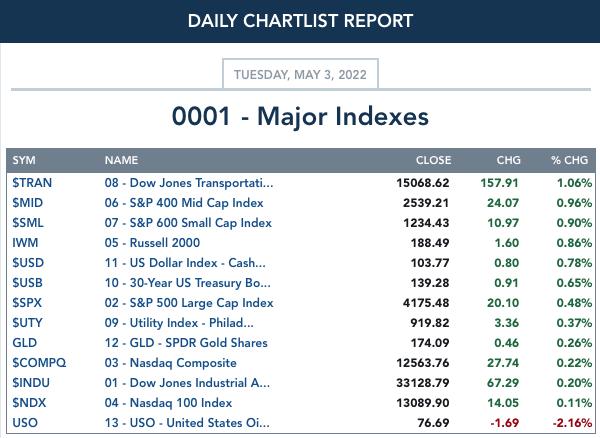
SECTORS
Each S&P 500 Index component stock is assigned to one of 11 major sectors. This is a snapshot of the Intermediate-Term (Silver Cross) and Long-Term (Golden Cross) Trend Model signal status for those sectors.
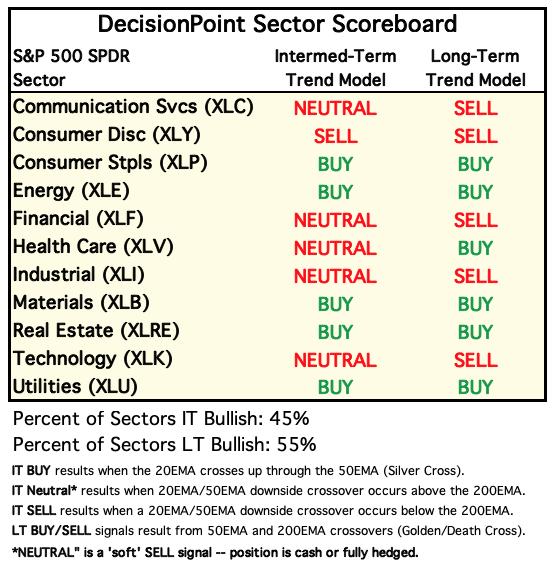
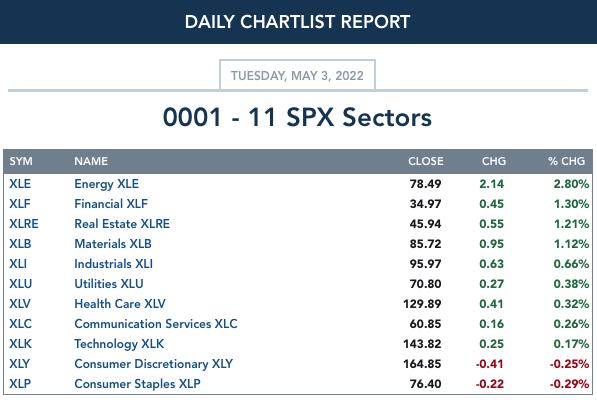
RRG® Chart: The following is a 100-year chart of $ONE. It has a constant value of 1.0, and it is the benchmark we use when we want to measure the relative rotation of price indexes against a "no change" index. When the market is going up, we want to find stocks/indexes that are performing better than the market, so we use SPY as the RRG benchmark. When the market is going down, we don't want to identify stocks that are just going down more slowly than SPY. We want to find stocks that are actually going up, so the $ONE benchmark is what we use for bear markets.
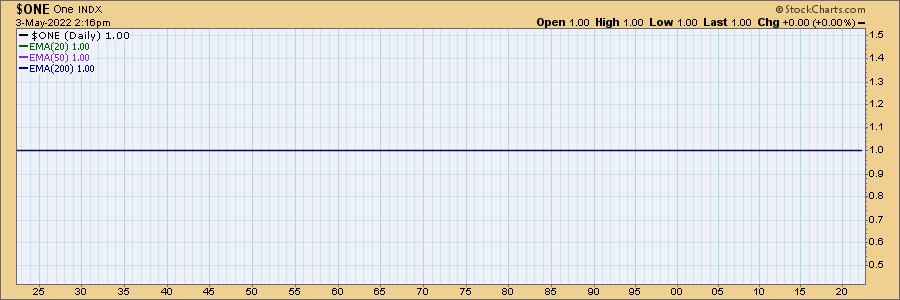
Below we have RRG charts for each benchmark. Please note that we will be using $ONE as our benchmark until we have an intermediate-term rising trend. Today we have both.
$ONE: Using $ONE as the benchmark, you can see that all sectors are either Lagging or Weakening. NONE of them have bullish headings. If this doesn't tell us we are in a bear market, nothing will. A few "bright" spots are Technology which is improving its heading as well as XLV and XLE. XLP is "strongest" given it isn't in the Lagging quadrant, but its bearish heading tells us that is changing.
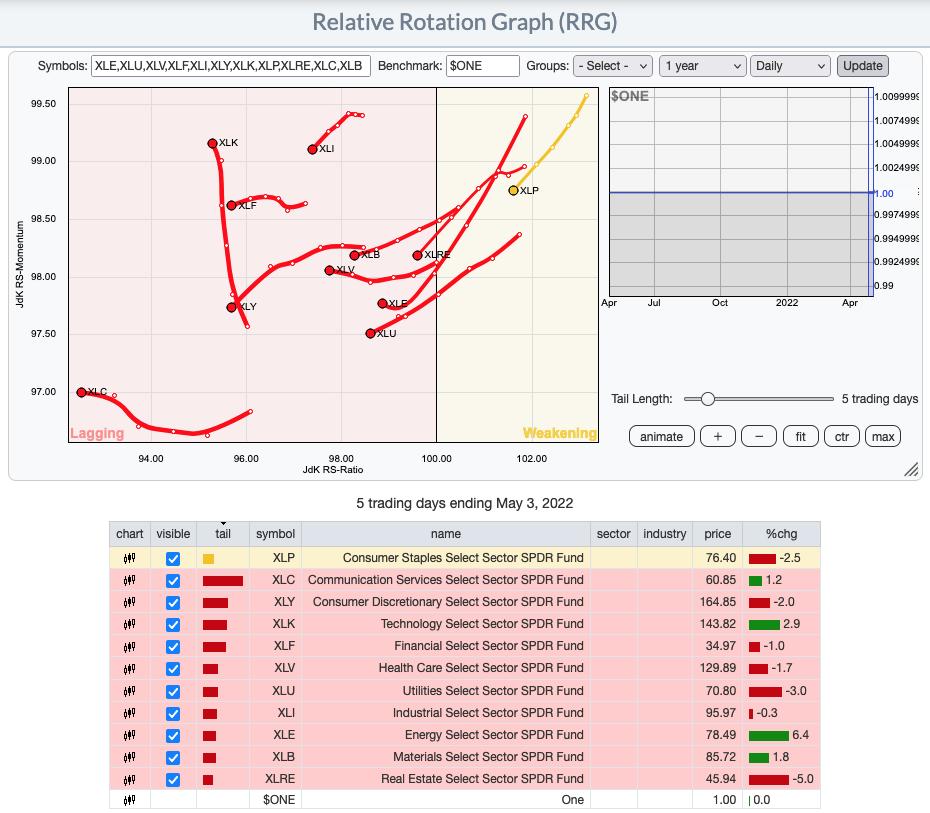
SPY: One thing that spurred us into using $ONE was seeing that XLK looked the most "bullish" relative to the SPY. We believe that sector is not as strong as it looks on this RRG. XLV is hooking back toward the Leading quadrant which is bullish, but it is still Weakening. XLI and XLP are in Leading, but are headed back toward the Weakening quadrant with somewhat bearish headings.
Most bearish are XLY and XLC, with XLY looking more bearish given its southwest heading. XLC is still lagging behind the SPY more than any other sector.
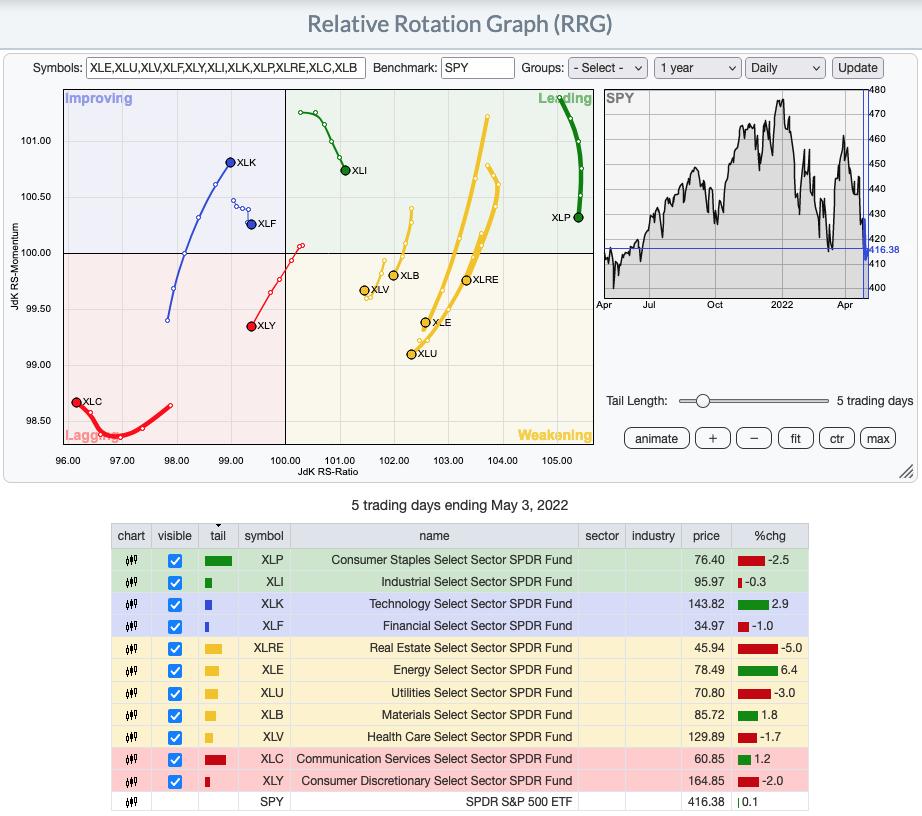
RRG® charts show you the relative strength and momentum for a group of stocks. Stocks with strong relative strength and momentum appear in the green Leading quadrant. As relative momentum fades, they typically move into the yellow Weakening quadrant. If relative strength then fades, they move into the red Lagging quadrant. Finally, when momentum starts to pick up again, they shift into the blue Improving quadrant.
CLICK HERE for an animated version of the RRG chart.
CLICK HERE for Carl's annotated Sector charts.
THE MARKET (S&P 500)
IT Trend Model: NEUTRAL as of 1/21/2022
LT Trend Model: BUY as of 6/8/2020
SPY Daily Chart: We have now identified a bullish falling wedge in the short term on the SPY. Indicators are still very bearish and Total Volume was light on today's rally that saw all of the sectors, with the exception of Consumer Discretionary (XLY) and Consumer Staples (XLP) moving higher. The VIX is seeing lower readings which has it moving higher on our inverted scale. This is bullish in the very short term.
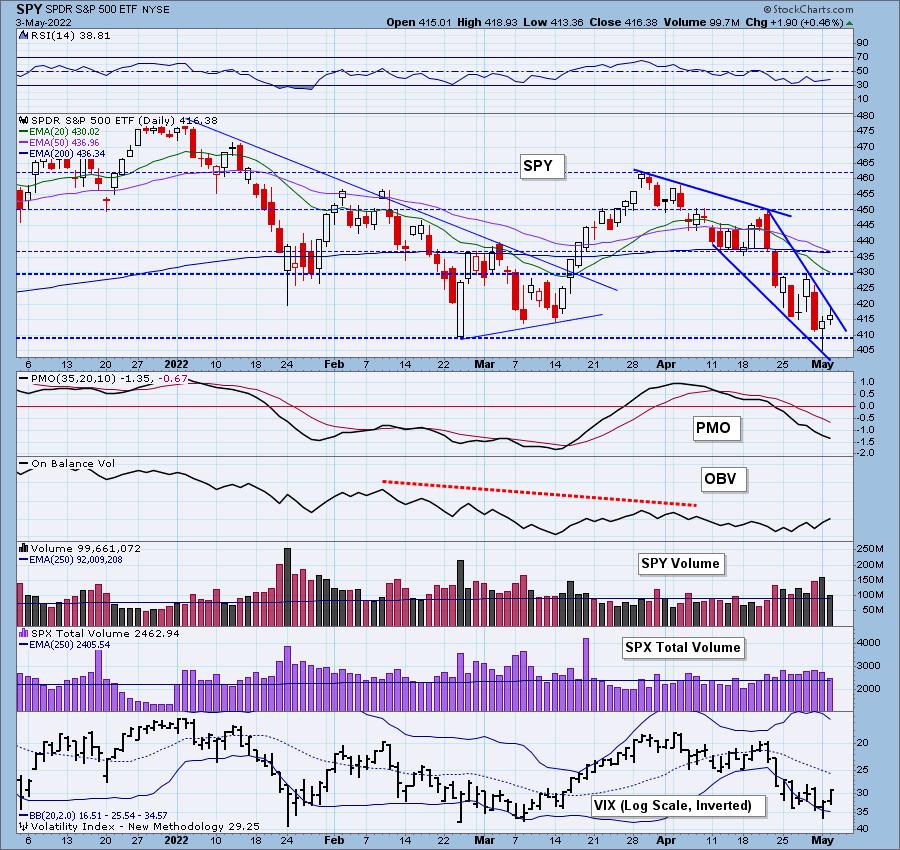
Indicators remain negative with the PMO still in decline and not fully oversold. The RSI is negative and Stochastics have topped again despite two days of rally.
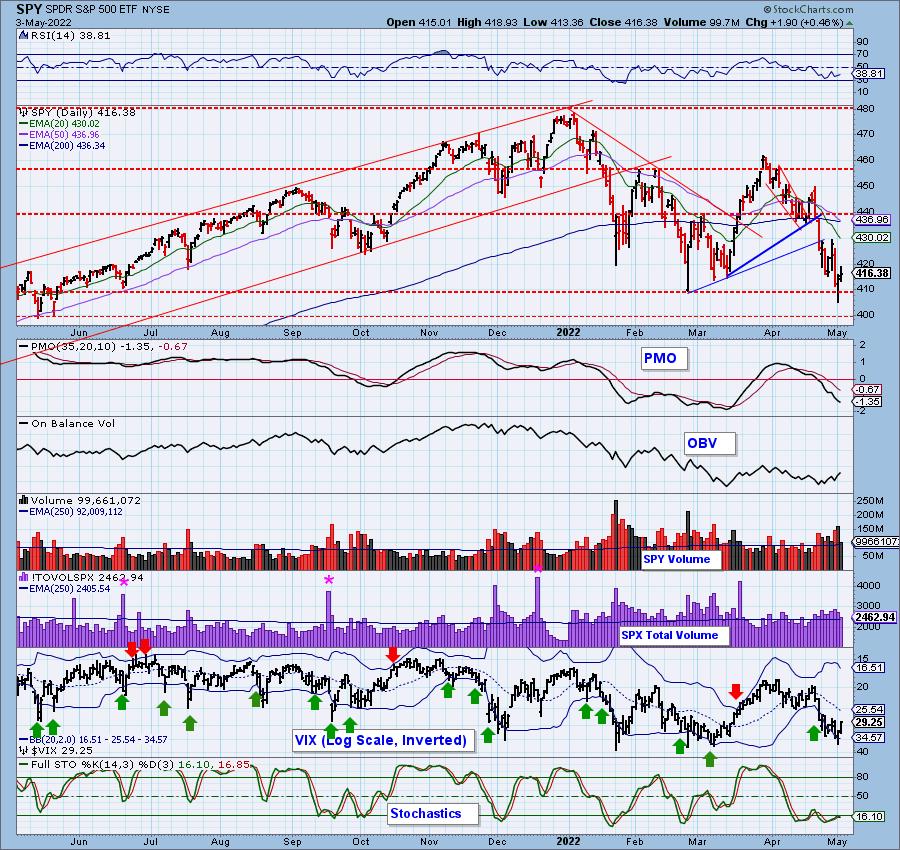
Here is the latest recording:
Topic: FREE DecisionPoint Trading Room
Start Time: May 2, 2022 09:00 AM
Meeting Recording Link.
Access Passcode: May#the2nd
S&P 500 New 52-Week Highs/Lows: New Highs and New Lows were negligible today. The 10-DMA of the High-Low Differential is showing signs of a possible bottom in oversold territory.
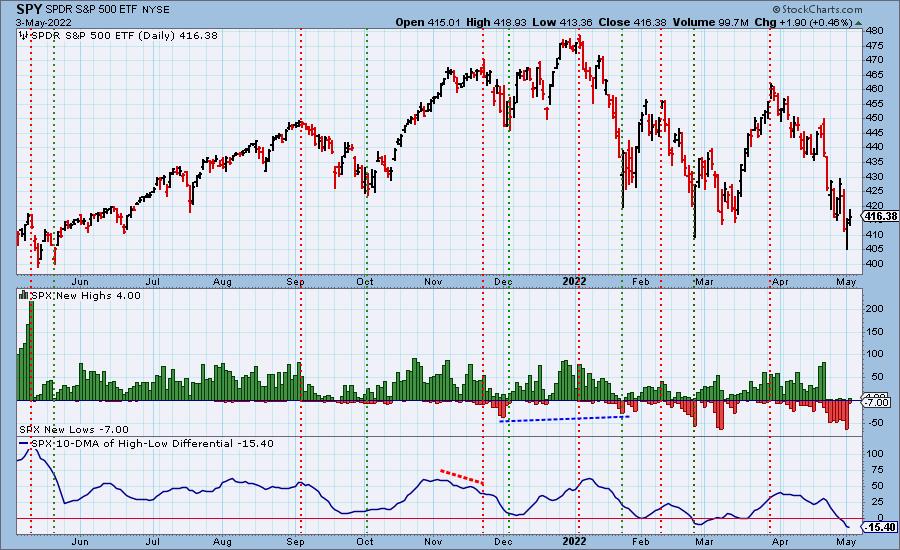
Climax* Analysis: There were marginal climactic readings today, although SPX Net A-D failed to make the grade. While we must call this an upside initiation climax, we think it is unlikely to lead anywhere.
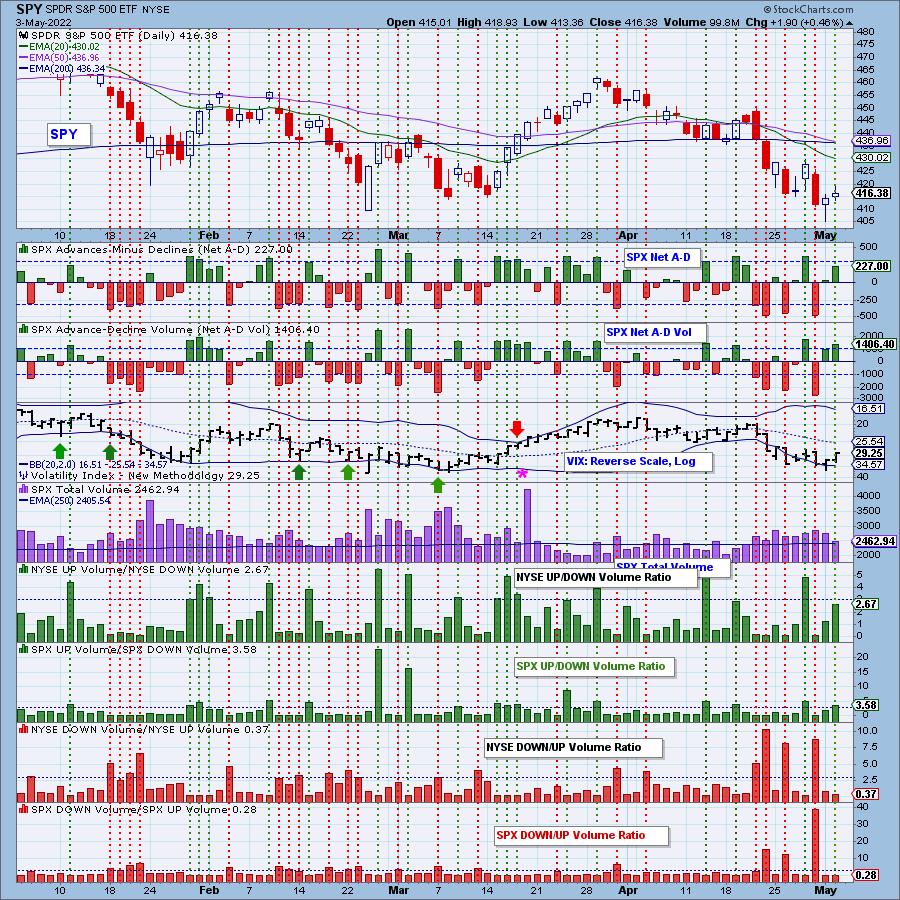
*A climax is a one-day event when market action generates very high readings in, primarily, breadth and volume indicators. We also include the VIX, watching for it to penetrate outside the Bollinger Band envelope. The vertical dotted lines mark climax days -- red for downside climaxes, and green for upside. Climaxes indicate either initiation or exhaustion.
Short-Term Market Indicators: The short-term market trend is DOWN and the condition is OVERSOLD.
The STOs are contracted out of negative territory which does seem to confirm the rally of the past two days. About one-third of the SPX are seeing positive momentum which is a good sign.
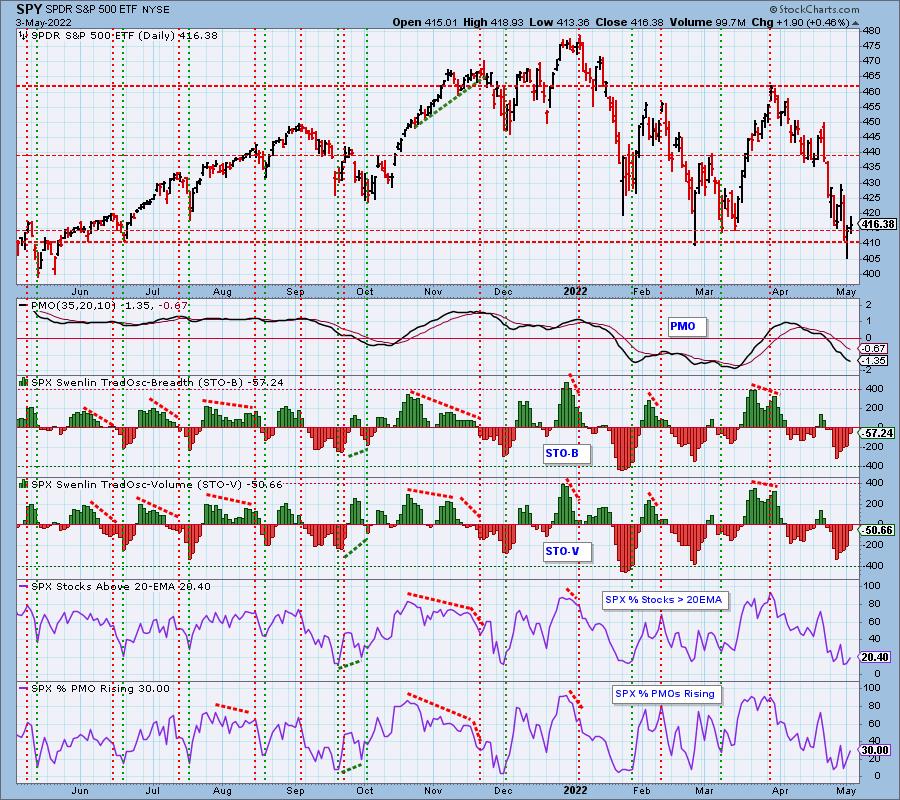
Intermediate-Term Market Indicators: The intermediate-term market trend is DOWN and the condition is SOMEWHAT OVERSOLD.
IT indicators are rising again which is positive, but we haven't seen a strong upside reversal on any of them.
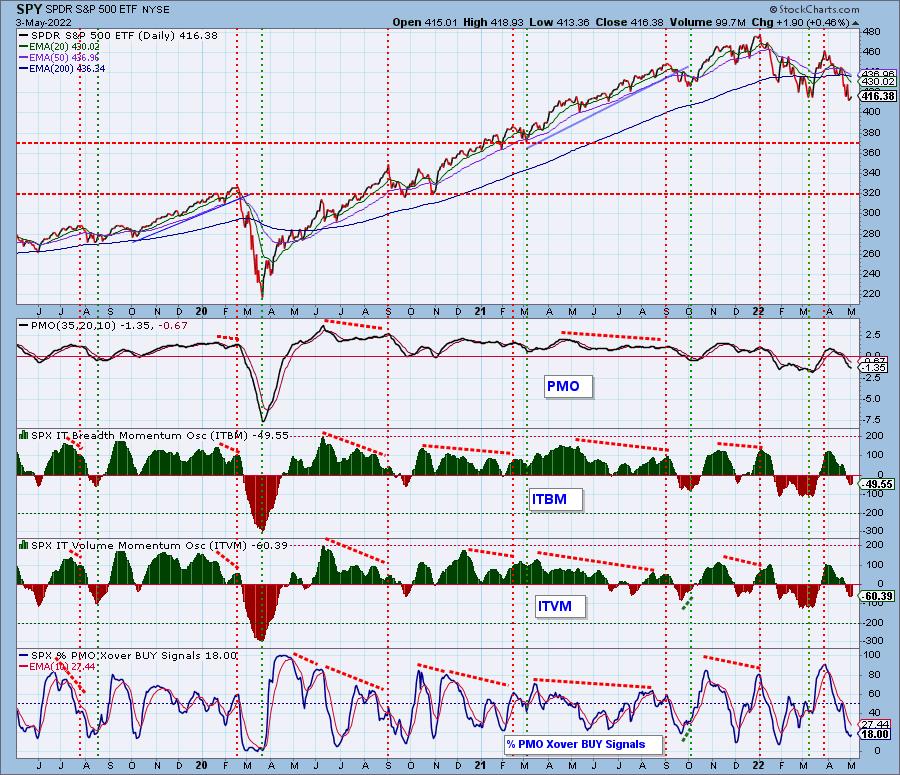
PARTICIPATION and BIAS Assessment: The following chart objectively shows the depth and trend of participation in two time frames.
- Intermediate-Term - the Silver Cross Index (SCI) shows the percentage of SPX stocks on IT Trend Model BUY signals (20-EMA > 50-EMA). The opposite of the Silver Cross is a "Dark Cross" -- those stocks are, at the very least, in a correction.
- Long-Term - the Golden Cross Index (GCI) shows the percentage of SPX stocks on LT Trend Model BUY signals (50-EMA > 200-EMA). The opposite of a Golden Cross is the "Death Cross" -- those stocks are in a bear market.
%Stocks above their 20/50/200-day EMAs are rising, but barely. Participation is still very low. On the bright side, the SCI looks ready to turn back up. We will need to see an actual bottom before we read this as bullish. Percentages across the board are well-below the 70% bullish threshold. We still see the bias in all three timeframes as bearish.
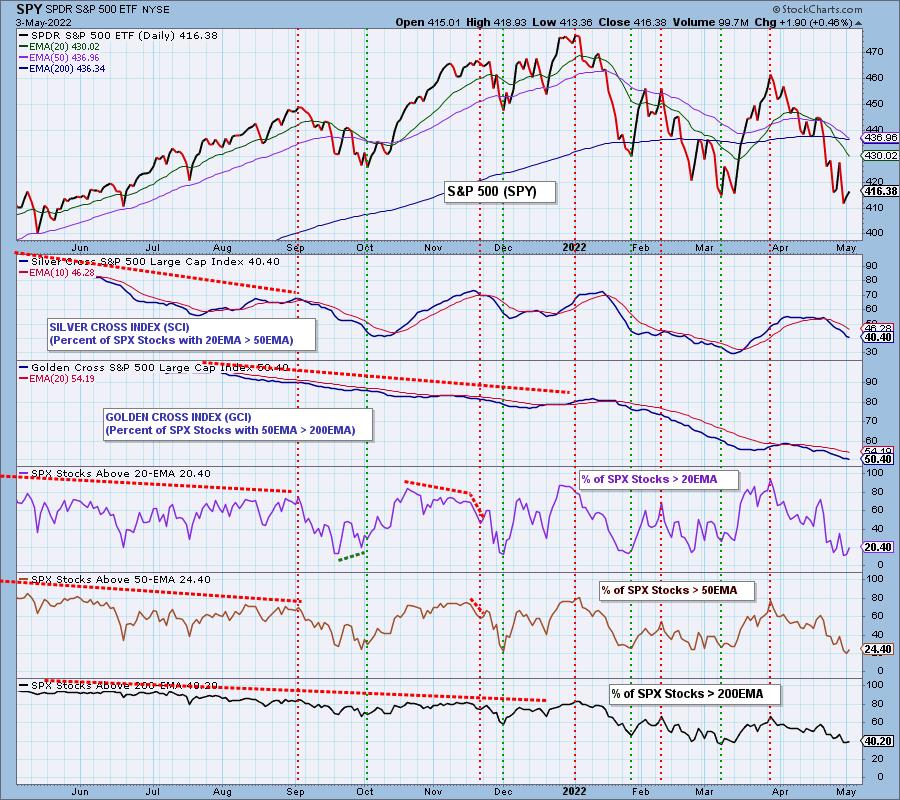
CONCLUSION: Tomorrow the Fed is expected to announce a 50 basis point interest rate increase. While this hike is "known" and likely "baked into" the price charts, wording of the statement will be highly scrutinized and could spur strong selling if investors don't like it. A bullish upside initiation climax paired with a bullish falling wedge and VIX readings moving lower should mean higher prices. Unfortunately, we are in a bear market and we've seen many bullish setups fail. If we do see a breakout from the bullish wedge with much improved participation, we can then consider a bear market rally ahead. For now it seems wise to "wait and see" what investors do with tomorrow's FOMC statement.
Erin is 15% exposed to the market and still considering adding some inverse ETFs or shorts.
Have you subscribed the DecisionPoint Diamonds yet? DP does the work for you by providing handpicked stocks/ETFs from exclusive DP scans! Add it with a discount! Contact support@decisionpoint.com for more information!
BITCOIN
Yesterday's comments still apply:
"Bitcoin is hovering above support at the March lows, $37,500. Indicators are flat or somewhat negative so a bounce here doesn't seem likely. As with the overall market, look for price to stay above this level but not make much headway to the upside side."
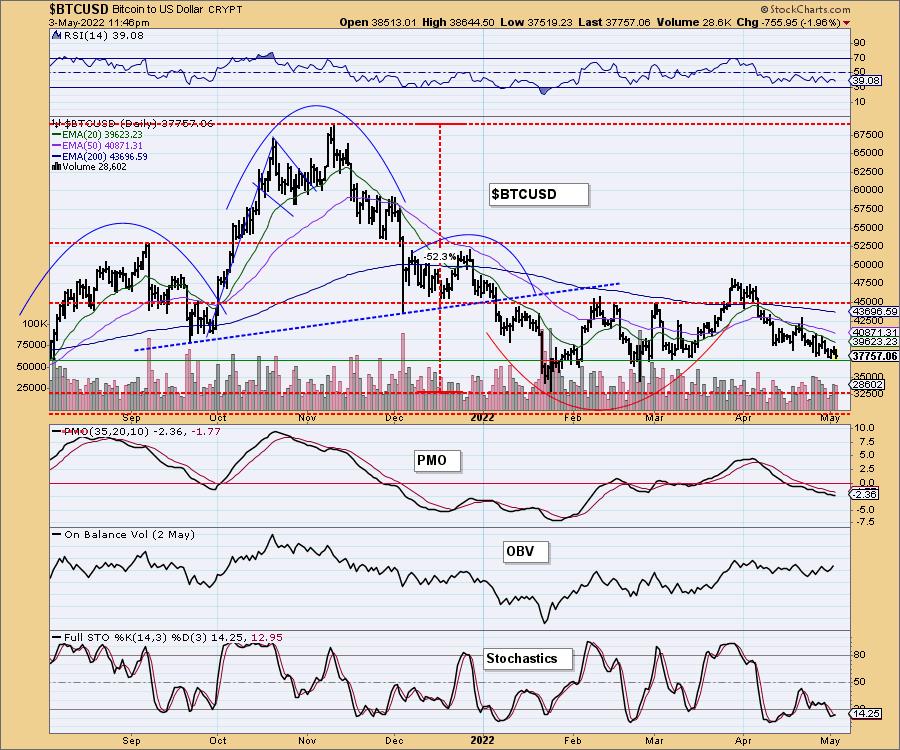
INTEREST RATES
Long-term yields broke out of their short-lived declining trends. With the FOMC raising the fed funds rate 50 basis points tomorrow, we don't see any relief in sight.
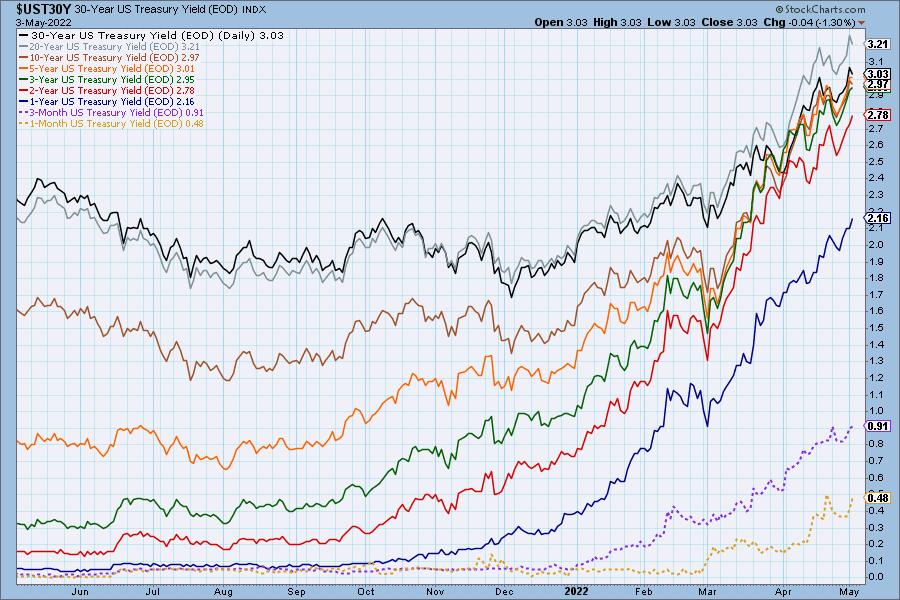
The Yield Curve Chart from StockCharts.com shows us the inversions taking place. The red line should move higher from left to right. Inversions are occurring where it moves downward.
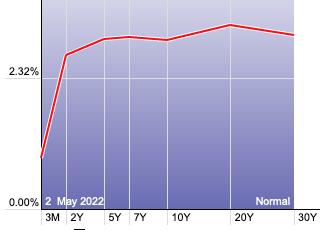
10-YEAR T-BOND YIELD
$TNX was lower today, but the rising trend is far from being compromised. The RSI left overbought territory and the PMO managed to unwind somewhat on the last pullback.
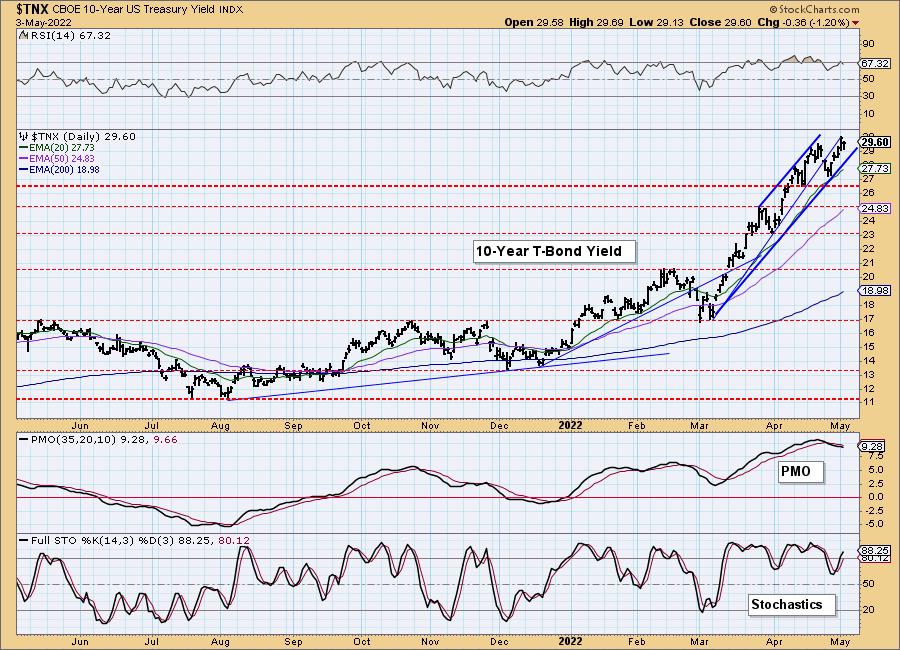
DOLLAR (UUP)
IT Trend Model: BUY as of 6/22/2021
LT Trend Model: BUY as of 8/19/2021
UUP Daily Chart: UUP is taking a pause after rising parabolically. Price isn't seeing much damage. This pause should help soften the steep rising trend we saw during the last half of April.
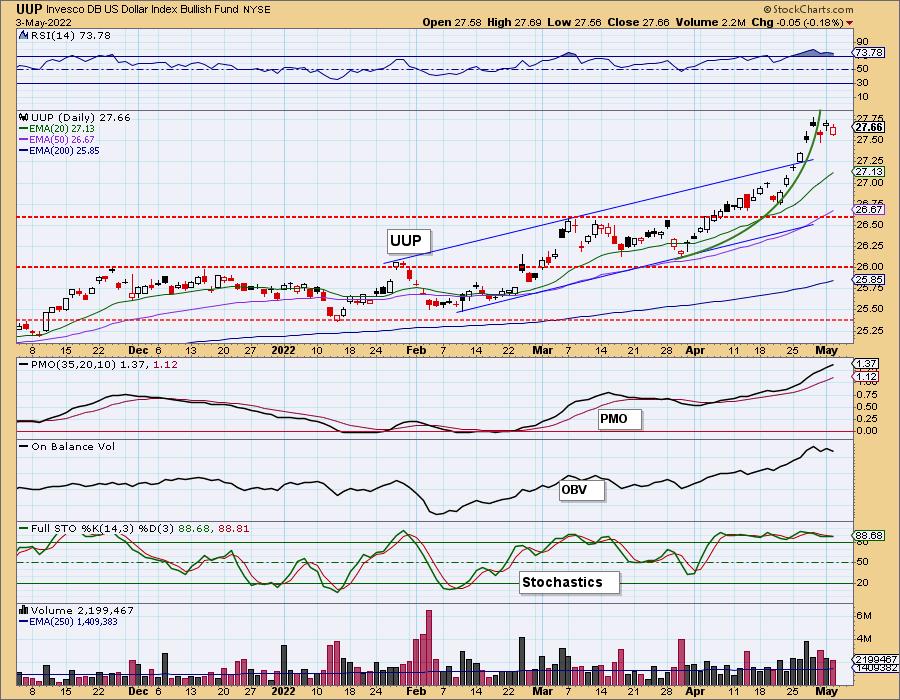
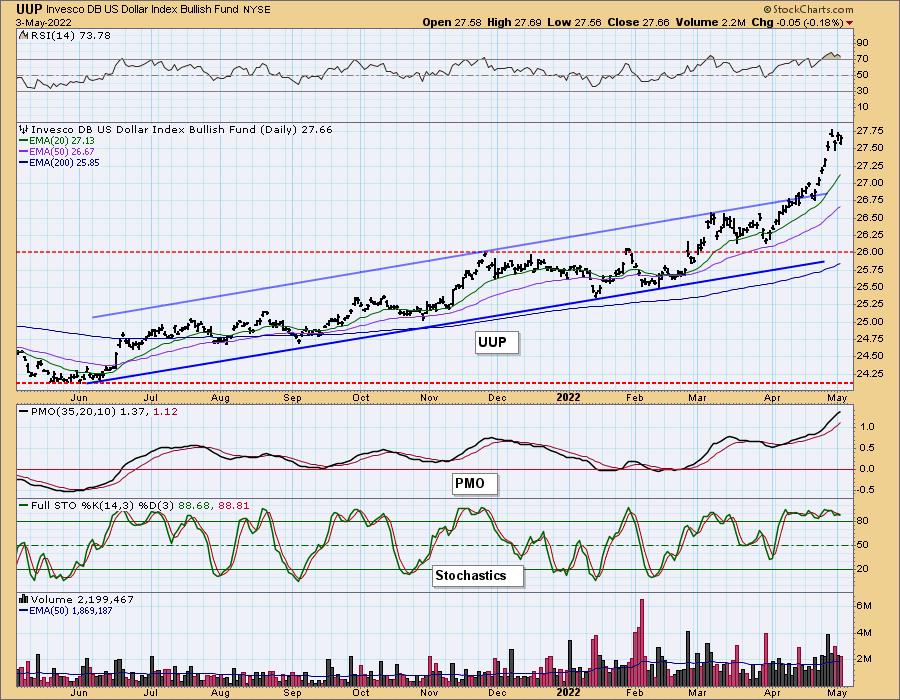
GOLD
IT Trend Model: NEUTRAL as of 5/3/2022
LT Trend Model: BUY as of 1/12/2022
GLD Daily Chart: As noted in the opening, GLD saw a "Dark Cross" of the 20/50-day EMAs that produced a new IT Trend Model Neutral signal. Had the crossover occurred beneath the 200-day EMA, it would've been a SELL signal. This is a fairly strong support zone for Gold given it lines up with January highs, the 200-day EMA and longer-term rising bottoms trendline.
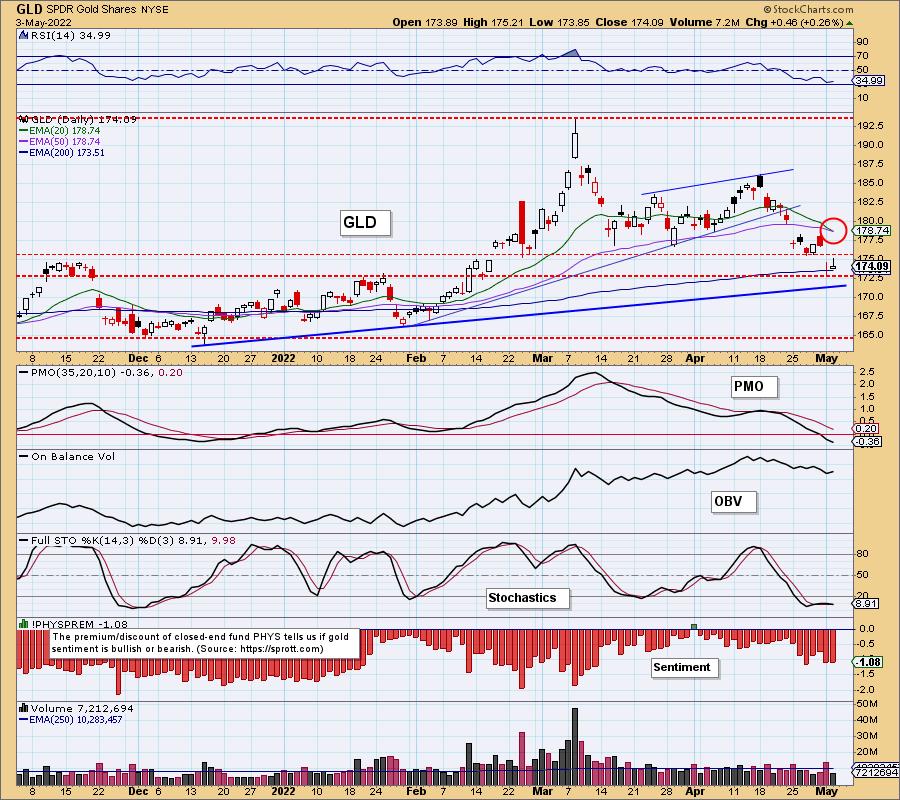
GOLD Daily Chart: Discounts remain somewhat elevated suggesting investors are still fairly bearish on Gold. That's not helping. The RSI is negative and the PMO is declining beneath the zero line. Stochastics are also negative. Still, this does look like an opportunity for Gold to rally given the Dollar is pausing its vertical rally.
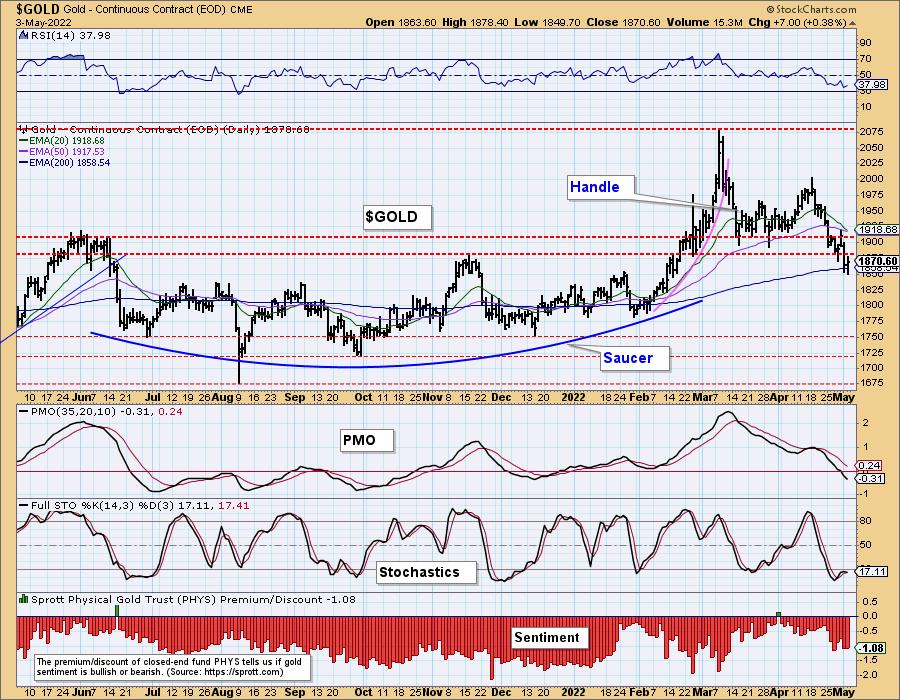
GOLD MINERS Golden and Silver Cross Indexes: GDX is bouncing off the 200-day EMA and support at the November high. While this is encouraging, indicators are not. Participation is not improving in a meaningful way. %Stocks > 20/50-day EMAs is paltry and the SCI is still declining quickly. The PMO is below the zero line and the RSI is in negative territory. Stochastics are mostly flat. Not enough positive data on this chart to imply this rally is sustainable.
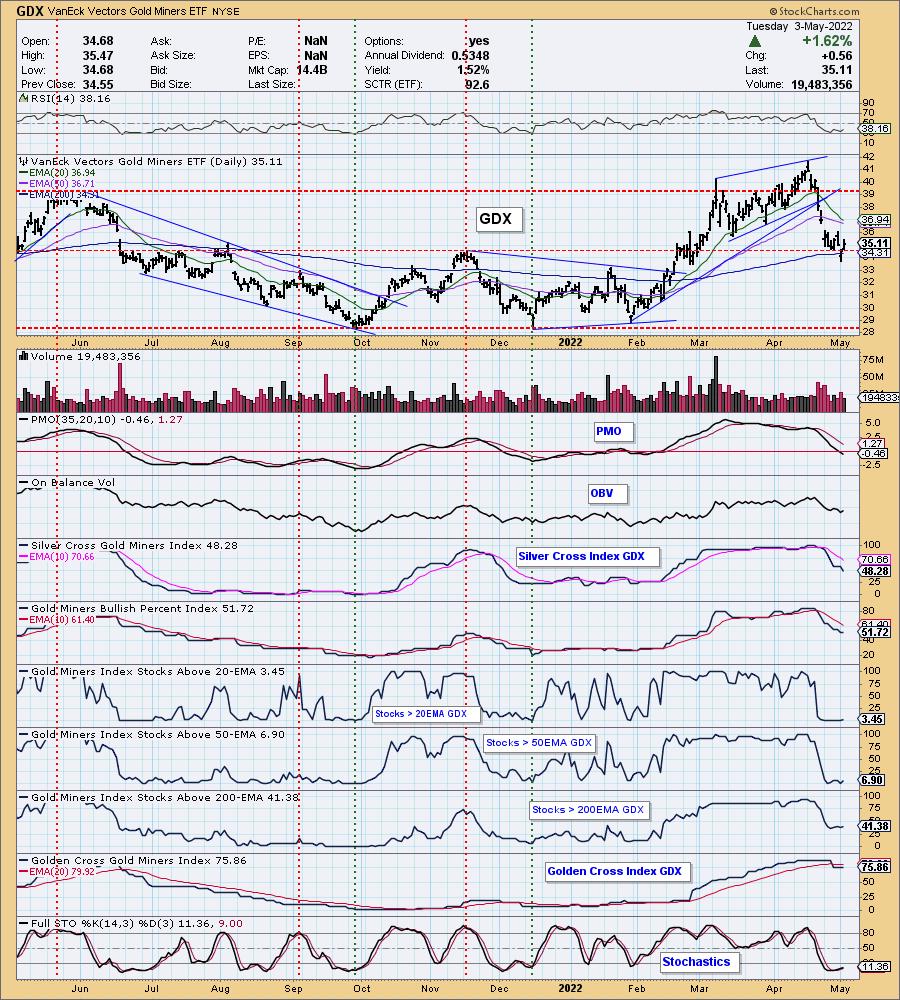
CRUDE OIL (USO)
IT Trend Model: BUY as of 1/3/2022
LT Trend Model: BUY as of 3/9/2021
USO Daily Chart: Yesterday's comments still apply:
"Crude Oil continues to consolidate sideways, forming a symmetrical triangle. These are continuation patterns so we expect an upside breakout that would continue the prior rising trend. The RSI is positive and Stochastics are rising in positive territory. The PMO isn't revealing much as it moves sideways with price. Overall, we expect the upside breakout will occur sooner rather than later."
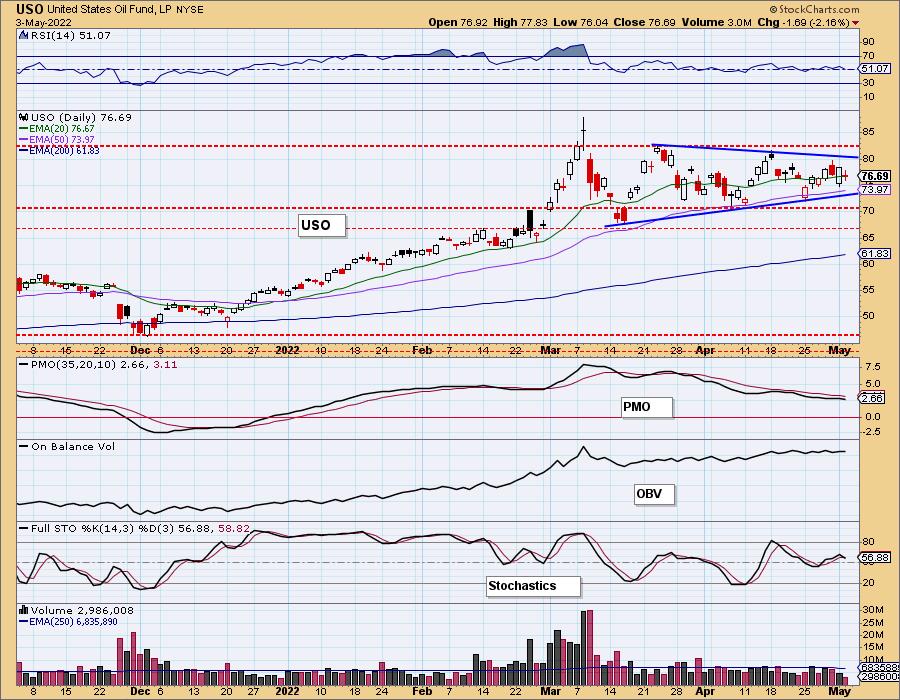
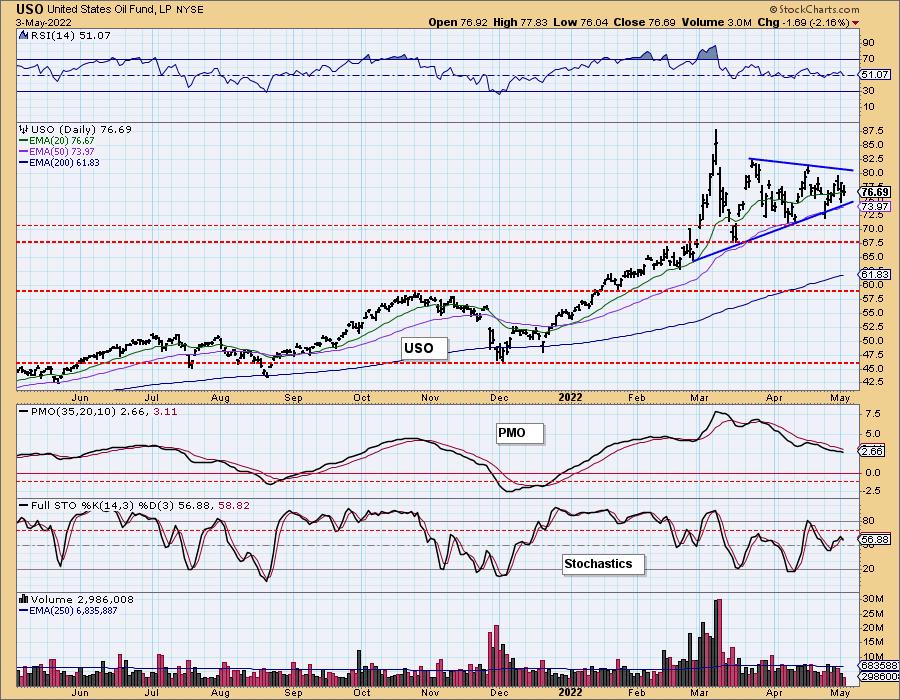
BONDS (TLT)
IT Trend Model: NEUTRALas of 1/5/2022
LT Trend Model: SELL as of 1/19/2022
TLT Daily Chart: Today saw a filled black candlestick on TLT. These are bearish one-day patterns so the expectation is a decline tomorrow. However, it is still within a bullish falling wedge pattern that implies an eventual breakout. TLT is in a bear market--a more severe bear market than the SPY. Bullish indicators and patterns have not fulfilled as expected on the SPY so we expect the same on an even more bearish TLT.
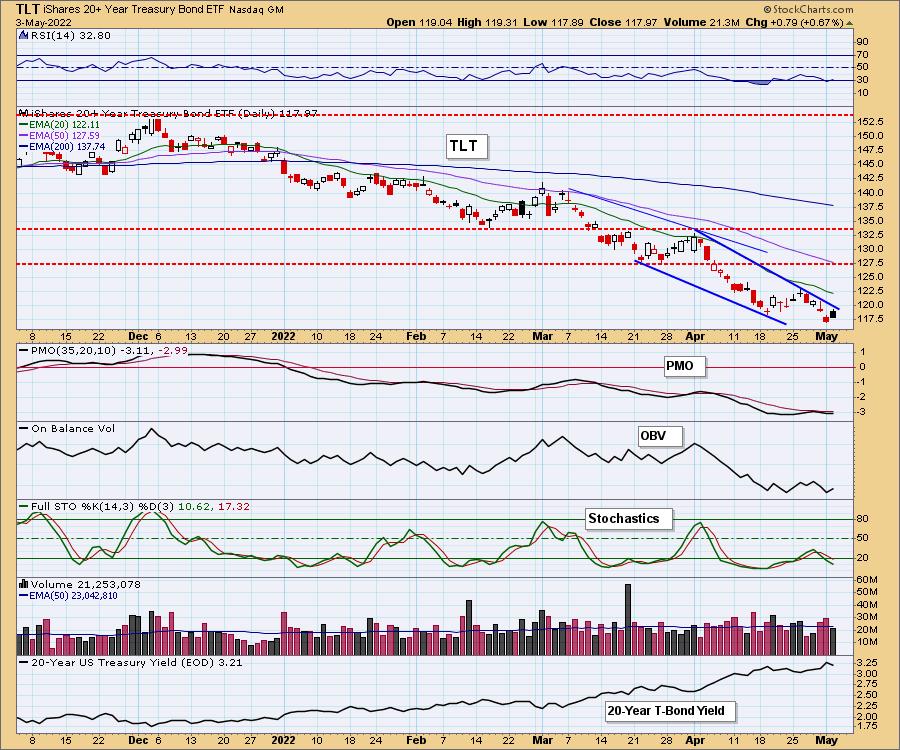
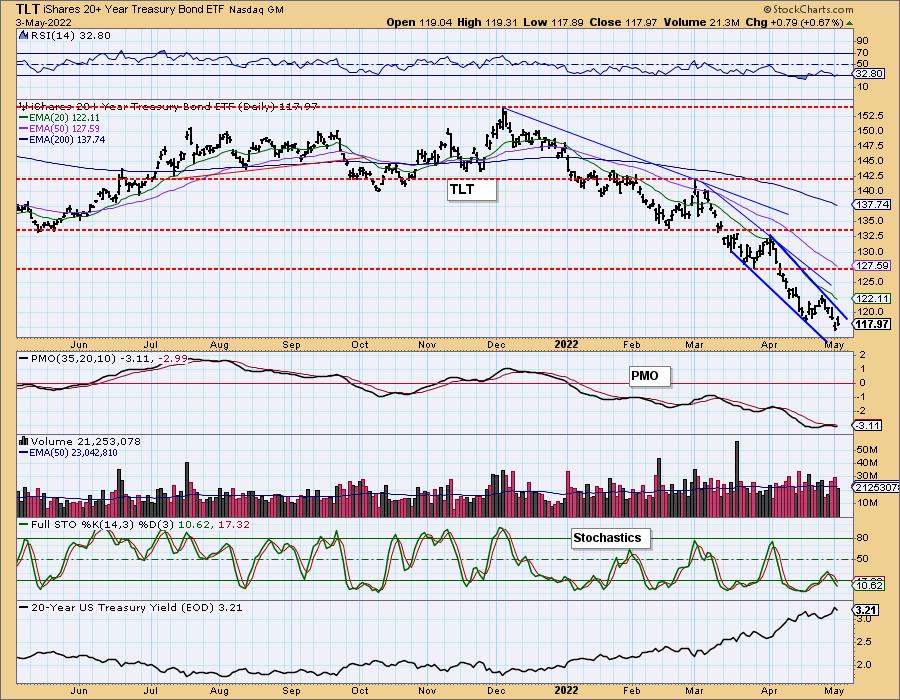
Good Luck & Good Trading!
Erin Swenlin
Technical Analysis is a windsock, not a crystal ball. --Carl Swenlin
(c) Copyright 2022 DecisionPoint.com
Disclaimer: This blog is for educational purposes only and should not be construed as financial advice. The ideas and strategies should never be used without first assessing your own personal and financial situation, or without consulting a financial professional. Any opinions expressed herein are solely those of the author, and do not in any way represent the views or opinions of any other person or entity.
NOTE: The signal status reported herein is based upon mechanical trading model signals, specifically, the DecisionPoint Trend Model. They define the implied bias of the price index based upon moving average relationships, but they do not necessarily call for a specific action. They are information flags that should prompt chart review. Further, they do not call for continuous buying or selling during the life of the signal. For example, a BUY signal will probably (but not necessarily) return the best results if action is taken soon after the signal is generated. Additional opportunities for buying may be found as price zigzags higher, but the trader must look for optimum entry points. Conversely, exit points to preserve gains (or minimize losses) may be evident before the model mechanically closes the signal.
Helpful DecisionPoint Links:
DecisionPoint Alert Chart List
DecisionPoint Golden Cross/Silver Cross Index Chart List
DecisionPoint Sector Chart List
Price Momentum Oscillator (PMO)
Swenlin Trading Oscillators (STO-B and STO-V)
DecisionPoint is not a registered investment advisor. Investment and trading decisions are solely your responsibility. DecisionPoint newsletters, blogs or website materials should NOT be interpreted as a recommendation or solicitation to buy or sell any security or to take any specific action.
